
C13
.pdf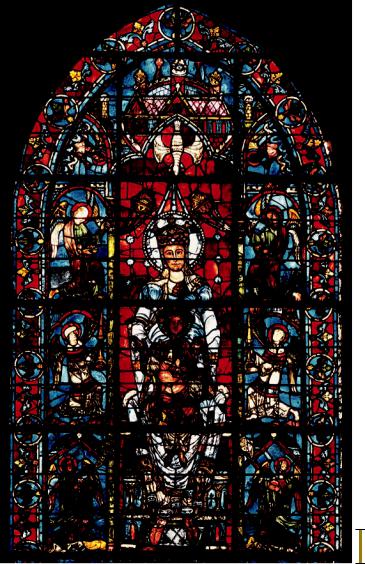
A change in vault design and the abandonment of the alternatesupport system usually accompanied this new bay arrangement. The High Gothic nave vault, which covered just one bay and therefore could be braced more easily than its Early Gothic predecessor, had only four parts. The visual effect of these changes was to unify the interior (FIG. 13-15). The High Gothic architect aligned identical units so that viewers saw them in too rapid a sequence to perceive them as individual volumes of space. The level crowns of the successive nave vaults, which pointed arches made possible, enhanced this effect. The nave became a vast, continuous hall.
The 1194 Chartres Cathedral was also the first church to have been planned from the beginning with flying buttresses, another key High Gothic feature. The flying buttresses allowed the builders to eliminate the tribune above the aisle, which had partially braced Romanesque and Early Gothic naves (compare FIG. 13-10c with FIGS. 13-10a and 13-10b). The new High Gothic tripartite nave elevation consisted of arcade, triforium, and clerestory with greatly enlarged windows. The Chartres windows are almost as tall as the main arcade and consist of double lancets with a single crowning oculus. The strategic placement of flying buttresses permitted the construction of nave walls with so many voids that heavy masonry played a minor role.
CHARTRES STAINED GLASS Despite the vastly increased size of the clerestory windows, the Chartres nave (FIG. 13-15) is relatively dark. The explanation for this seeming contradiction is that light-suppressing colored glass fills the windows. The purpose of these windows was not to illuminate the interior with bright sunlight but to transform natural light into Suger’s mystical lux nova (see “Stained-Glass Windows,” page 350). Chartres retains almost the full complement of its original stained glass, which, although it has a dimming effect, transforms the character of the interior in dramatic fashion. Gothic churches that have lost their original stained-glass windows give a false impression of what their designers intended.
One Chartres window that survived the fire of 1194 and was subsequently reused in the High Gothic cathedral is the tall single lancet the French call Notre Dame de la Belle Verrière (Our Lady of the Beautiful Window, FIG. 13-16). The central section, depicting against a red background the Virgin Mary enthroned with the Christ Child in her lap, dates to about 1170. Glaziers added the framing angels seen against a blue ground when they reinstalled the window in the 13thcentury choir. The frontal composition is traditional, but Mary is now the beautiful, young, rather worldly Queen of Heaven, haloed, crowned, and accompanied by the dove of the Holy Spirit. Comparing this Virgin and Child with the Theotokos and Child (FIG. 9-19) of Hagia Sophia highlights not only the greater severity and aloofness of the Byzantine image but also the sharp difference between the lightreflecting mosaic medium and Gothic light-filtering stained glass. Gothic and Byzantine builders used light to transform the material world into the spiritual, but in opposite ways. In Gothic architecture, light entered from outside the building through a screen of stone-set colored glass. In Byzantine architecture, light reflected off myriad glass tesserae set into the thick masonry wall.
Chartres’s 13th-century Gothic windows are even more spectacular than the Belle Verrière because, thanks to the introduction of flying buttresses, the builders could plan from the outset to fill entire walls with stained glass. The immense rose window (approximately 43 feet in diameter) and tall lancets of Chartres Cathedral’s north transept (FIG. 13-1) were the gift of the French queen Blanche of Castile, around 1220. The royal motifs of yellow castles on a red ground and yellow fleurs-de-lis—three-petaled iris flowers—on a blue ground fill the eight narrow windows in the rose’s lower spandrels. The iconography is also fitting for a queen. The enthroned Virgin and Child appear in the
1 ft.
13-16 Virgin and Child and angels (Notre Dame de la Belle Verrière), detail of a window in the choir of Chartres Cathedral, Chartres, France, ca. 1170, with 13th-century side panels. Stained glass, full height 16 .
This stained-glass window miraculously survived the devastating Chartres fire of 1194. It has an armature of iron bands that forms a grid over the whole design, an Early Gothic characteristic.
roundel at the center of the rose, which resembles a gem-studded book cover or cloisonné brooch. Around her are four doves of the Holy Spirit and eight angels. Twelve square panels contain images of Old Testament kings, including David and Solomon (at the 12 and 1 o’clock positions respectively). These are the royal ancestors of Christ. Isaiah (11:1–3) had prophesied that the Messiah would come from the family of the patriarch Jesse, father of David. The genealogical “tree of Jesse” is a familiar motif in medieval art. Below, in the lancets, are Saint Anne and the baby Virgin. Flanking them are four of Christ’s Old Testament ancestors, Melchizedek, David, Solomon, and Aaron, echoing the royal genealogy of the rose but at a larger scale. Many Gothic stained-glass windows also present narrative scenes, and their iconographical programs are sometimes as complex as those of the sculptured church portals.
The rose and lancets change in hue and intensity with the hours, turning solid architecture into a floating vision of the celestial heavens. Almost the entire mass of wall opens up into stained glass, held in place by an intricate stone armature of bar tracery. Here, the
French Gothic |
349 |
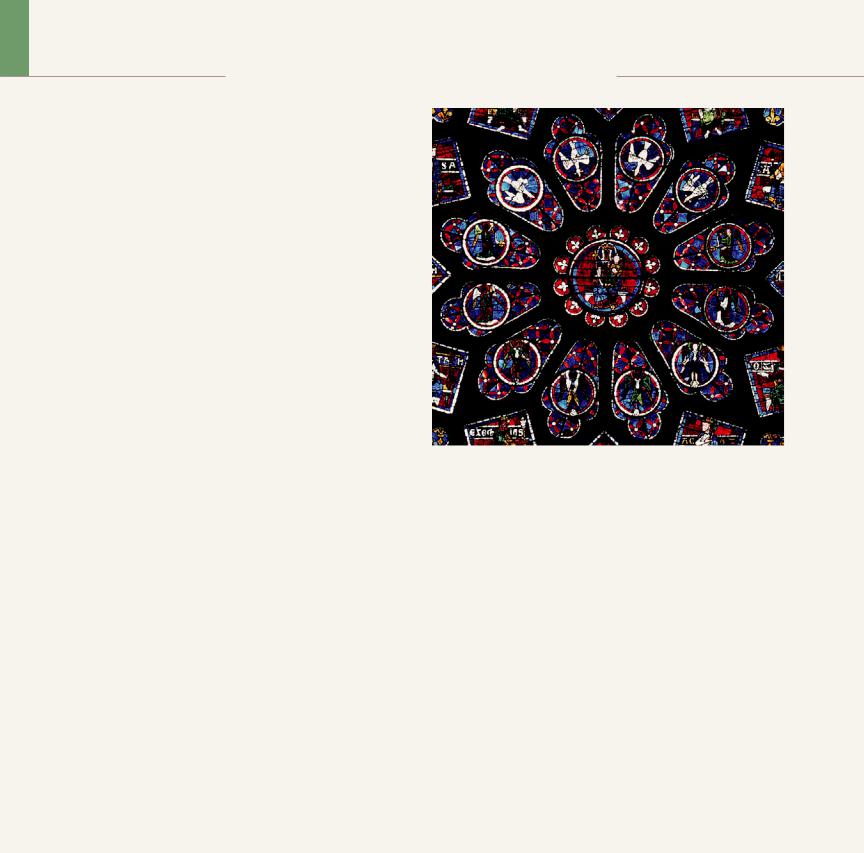
M A T E R I A L S A N D T E C H N I Q U E S
Stained-Glass Windows
Athough not a Gothic invention, stained-glass windows are almost synonymous with Gothic architecture. No other age pro-
duced windows of such rich color and beauty. The technology of |
|
|
|
|
|
manufacturing colored glass is very old, however. Egyptian artists ex- |
|
|
|
|
|
celled at fashioning colorful glass objects for both home and tomb, |
|
|
|
|
|
and archaeologists have also uncovered thousands of colored-glass |
|
|
|
|
|
artifacts at classical sites. But Gothic artists used stained glass in new |
|
|
|
|
|
ways. In earlier eras, the clergy introduced color and religious iconog- |
|
|
|
|
|
raphy into church interiors with mural paintings and mosaics, often |
|
|
|
|
|
with magnificent effect. Stained-glass windows differ from those |
|
|
|
|
|
techniques in one all-important respect. They do not conceal walls. |
|
|
|
|
|
They replace them. And they transmit rather than reflect light, filter- |
|
|
|
|
|
ing and transforming the natural sunlight. |
|
|
|
|
|
Abbot Suger called this colored light lux nova (see “Abbot Suger,” |
|
|
|
|
|
page 341). Suger’s contemporary, Hugh of Saint-Victor (1096–1142), |
|
|
|
|
|
a prominent Parisian theologian, also commented on the special |
|
|
|
|
|
mystical quality of stained-glass windows: “Stained-glass windows |
|
|
|
|
|
are the Holy Scriptures . . . and since their brilliance lets the splendor |
|
|
|
|
|
of the True Light pass into the church, they enlighten those inside.”* |
|
|
|
|
|
William Durandus, bishop of Mende, expressed a similar sentiment |
|
|
|
|
|
at the end of the 13th century: “The glass windows in a church are |
|
|
|
|
|
|
|
1 ft. |
|||
Holy Scriptures, which expel the wind and the rain, that is, all things |
Detail of stained-glass rose window, north transept Chartres Cathedral, |
|
|
||
hurtful, but transmit the light of the True Sun, that is, God, into the |
|||||
Chartres, France, ca. 1220 (see FIG. 13-1). |
|||||
hearts of the faithful.Ӡ As early as the fourth century, architects used |
|||||
|
|
|
|
||
colored glass for church windows, and the stained-glass windows of |
|
|
|
|
|
Saint-Denis (FIG. 13-3) already show a high degree of skill. According |
distinctive character of Gothic stained-glass windows is largely the |
||||
to Suger, they were “painted by the exquisite hands of many masters |
result of this combination of fine linear details with broad flat ex- |
||||
from different regions,”‡ proving that the art was well established at |
panses of color framed by black lead. Finally, the glassworkers |
||||
that time. In fact, several fine Romanesque examples survive. |
strengthened the completed window with an armature of iron bands, |
||||
The manufacture of stained-glass windows was costly and labor- |
which in the 12th century formed a grid over the whole design (FIG. |
||||
intensive. A Benedictine monk named Theophilus recorded the full |
13-16). In the 13th century, the bands followed the outlines of the |
||||
process around 1100. First, the master designer drew the exact com- |
medallions and of the surrounding areas (FIGS. 13-1 and 13-25). |
||||
position of the planned window on a wooden panel, indicating all the |
The form of the stone frames for the stained-glass windows also |
||||
linear details and noting the colors for each section. Glassblowers |
evolved. On Chartres Cathedral’s 12th-century west facade (FIG. 13-5), |
||||
provided flat sheets of glass of different colors to glaziers (glasswork- |
plate tracery holds the rose window in place. The glass fills only the |
||||
ers), who cut the windowpanes to the required size and shape with |
“punched holes” in the heavy ornamental stonework. Bar tracery, a |
||||
special iron shears. Glaziers produced an even greater range of colors |
later development, is much more slender. The 13th-century stained- |
||||
by flashing (fusing one layer of colored glass to another). Next, |
glass windows (FIG. 13-1) of the Chartres transepts fill almost the |
||||
painters added details such as faces, hands, hair, and clothing in |
entire opening, and the stonework is unobtrusive, more like delicate |
||||
enamel by tracing the master design on the wood panel through the |
leading than masonry wall. |
||||
colored glass. Then they heated the painted glass to fuse the enamel |
* Hugh of Saint-Victor, Speculum de mysteriis ecclesiae, Sermon 2. |
||||
to the surface. At that point, the glaziers “leaded” the various frag- |
|||||
† William Durandus, Rationale divinorum officiorum, 1.1.24. Translated by John |
|||||
ments of glass—that is, they joined them by strips of lead called |
Mason Neale and Benjamin Webb, The Symbolism of Churches and Church Orna- |
||||
cames. The leading not only held the pieces together but also sepa- |
ments (Leeds: T. W. Green, 1843), 28. |
||||
rated the colors to heighten the effect of the design as a whole. The |
‡ Translated by Erwin Panofsky, Abbot Suger, 73. |
||||
Gothic passion for luminous colored light led to a most daring and successful attempt to subtract all superfluous material bulk just short of destabilizing the structure. That this vast, complex fabric of stone-set glass has maintained its structural integrity for almost 800 years attests to the Gothic builders’ engineering genius.
CHARTRES SOUTH TRANSEPT The sculptures adorning the portals of the two new Chartres transepts erected after the 1194
fire are also prime examples of the new High Gothic spirit. As at Laon (FIG. 13-8) and Paris (FIG. 13-11), the Chartres transept portals project more forcefully from the church than do the Early Gothic portals of its west facade (compare FIGS. 13-5 and 13-13). Similarly, the statues of saints on the portal jambs are more independent of the architectural framework. Three figures (FIG. 13-17) from the Porch of the Confessors in the south transept reveal the great changes Gothic sculpture underwent since the Royal Portal statues (FIG. 13-7) of the
350 Chapter 13 G OT H I C E U RO P E
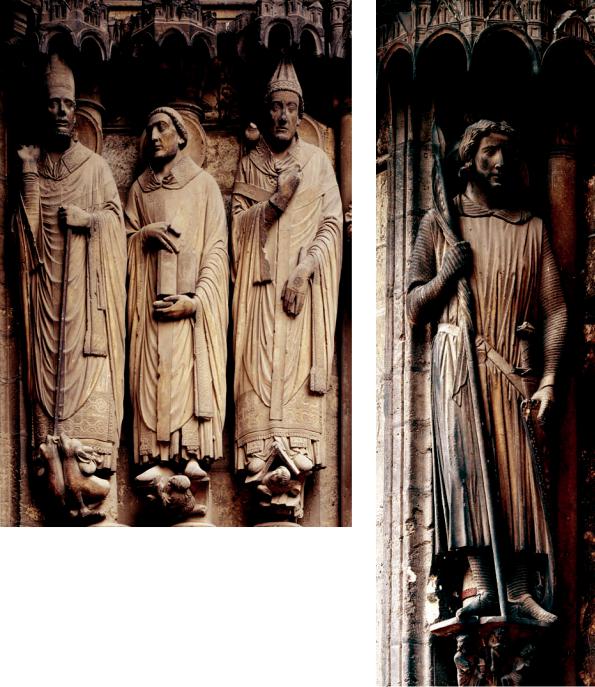
13-17 Saints Martin, Jerome, and Gregory, jamb statues, Porch of the Confessors (right doorway), south transept, Chartres Cathedral, Chartres, France, ca. 1220–1230.
In contrast to the Royal Portal statues (FIG. 13-7), the south-transept statues have individual personalities and turn slightly to left or right, breaking the rigid vertical lines of their 12th-century predecessors.
13-18 Saint Theodore, jamb statue, Porch of the Martyrs (left doorway), south transept, Chartres Cathedral, Chartres, France, ca. 1230.
Although the statue of Theodore is still attached to a column, the setting no longer determines its pose. The High Gothic sculptor portrayed the saint swinging out one hip, as in Greek statuary (FIG. 5-40).
mid-12th century. These changes recall in many ways the revolutionary developments in ancient Greek sculpture during the transition from the Archaic to the Classical style (see Chapter 5). The southtransept statues date from 1220 to 1230 and represent Saints Martin, Jerome, and Gregory. Although the figures are still attached to columns, the architectural setting does not determine their poses as much as it did on the west portals. The saints communicate quietly with one another, like waiting dignitaries. They turn slightly toward and away from each other, breaking the rigid vertical lines that fix the Royal Portal figures immovably. The drapery folds are not stiff and shallow vertical accents, as on the west facade. The fabric falls and laps over the bodies in soft, if still regular, folds.
The treatment of the faces is even more remarkable. The sculptor gave the figures individualized features and distinctive personalities and clothed them in the period’s liturgical costumes. Saint Martin is a tall, intense priest with gaunt features (compare the spiritually moved but not particularized face of the Moissac prophet in 12-11). Saint Jerome appears as a kindly, practical administratorscholar, holding his copy of the Scriptures. At the right, the introspective Saint Gregory seems lost in thought as he listens to the dove
of the Holy Ghost on his shoulder. Thus, the sculptor did not contrast the three men simply in terms of their poses, gestures, and attributes but as persons. Personality, revealed in human faces, makes the profound difference.
The south-transept figure of Saint Theodore (FIG. 13-18), the martyred warrior on the Porch of the Martyrs, presents an even sharper contrast with Early Gothic jamb statues. The sculptor portrayed Theodore as the ideal Christian knight and clothed him in the cloak and chain-mail armor of Gothic Crusaders. The handsome, long-haired youth holds his spear firmly in his right hand and rests his left hand on his shield. He turns his head to the left and swings out his hip to the right. The body’s resulting torsion and pronounced sway call to mind Greek statuary, especially the contrapposto stance of Polykleitos’s Spear Bearer (FIG. 5-40). The changes that occurred in 13th-century Gothic sculpture could appropriately be labeled a second “Classical revolution.”
French Gothic |
351 |
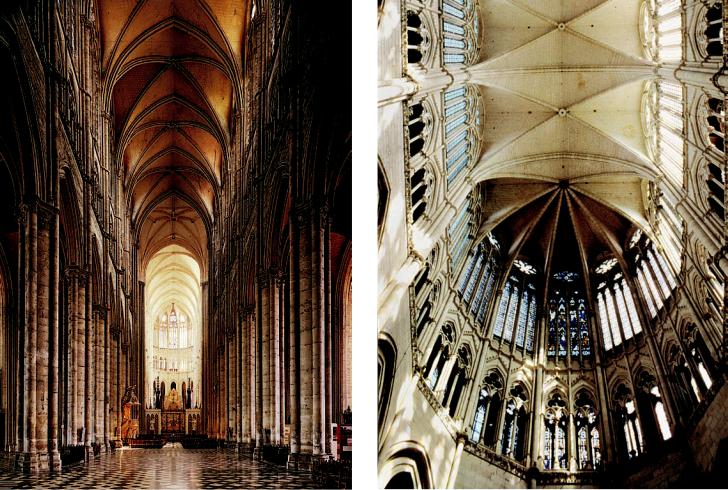
13-19 ROBERT DE LUZARCHES, THOMAS DE CORMONT, and
RENAUD DE CORMONT, interior of Amiens Cathedral (looking east), Amiens, France, begun 1220.
The concept of a self-sustaining skeletal architecture reached full maturity at Amiens Cathedral. The four-part High Gothic vaults on pointed arches rise an astounding 144 feet above the nave floor.
AMIENS CATHEDRAL Chartres Cathedral was one of the most influential buildings in the history of architecture. Its builders set a pattern that many other Gothic architects followed, even if they refined the details. Construction of Amiens Cathedral (FIGS. 13-19 to 13-21) began in 1220, while work was still in progress at Chartres.
The architects were ROBERT DE LUZARCHES, THOMAS DE CORMONT,
and RENAUD DE CORMONT. The builders finished the nave by 1236 and the radiating chapels by 1247, but work on the choir continued until almost 1270. The Amiens elevation (FIGS. 13-10d and 13-19) derived from the High Gothic formula of Chartres (FIGS. 13-10c and 13-15). But Amiens Cathedral’s proportions are even more elegant, and the number and complexity of the lancet windows in both its clerestory and triforium are even greater. The whole design reflects the builders’ confident use of the complete High Gothic structural vocabulary: the rectangular-bay system, the four-part rib vault, and a buttressing system that permitted almost complete dissolution of heavy masses and thick weight-bearing walls. At Amiens, the concept of a self-sustaining skeletal architecture reached full maturity. The remaining stretches of wall seem to serve no purpose other than to provide a weather screen for the interior (FIG. 13-20).
Amiens Cathedral is one of the most impressive examples of the French Gothic obsession with constructing ever taller churches. Using
352 Chapter 13 G OT H I C E U RO P E
13-20 ROBERT DE LUZARCHES, THOMAS DE CORMONT, and RENAUD
DE CORMONT, vaults, clerestory, and triforium of the choir of Amiens Cathedral, Amiens, France, begun 1220.
The Amiens choir vaults resemble a canopy suspended from bundled masts. The sunlight entering from the clerestory creates the effect of a buoyant lightness not normally associated with stone architecture.
their new skeletal frames of stone, French builders attempted goals almost beyond limit, pushing to new heights with increasingly slender supports. The nave vaults at Laon rise to a height of about 80 feet, at Paris 107 feet, and at Chartres 118 feet. Those at Amiens are 144 feet above the floor (FIG. 13-10). The tense, strong lines of the Amiens vault ribs converge at the colonnettes and speed down the shell-like walls to the compound piers. Almost every part of the superstructure has its corresponding element below. The overall effect is of effortless strength, of a buoyant lightness not normally associated with stone architecture. Viewed directly from below, the choir vaults (FIG. 13-20) seem like a canopy, tentlike and suspended from bundled masts. The light flooding in from the clerestory makes the vaults seem even more insubstantial. The effect recalls another great building, one utterly different from Amiens but where light also plays a defining role: Hagia Sophia (FIG. 9-4) in Constantinople. Once again, the designers reduced the building’s physical mass by structural ingenuity and daring, and light further dematerializes what remains. If Hagia Sophia is the perfect expression of Byzantine spirituality in architecture, Amiens, with its soaring vaults and giant windows admitting divine colored light, is its Gothic counterpart.
Work began on the Amiens west facade (FIG. 13-21) at the same time as the nave (1220). Its lower parts reflect the influence of Laon
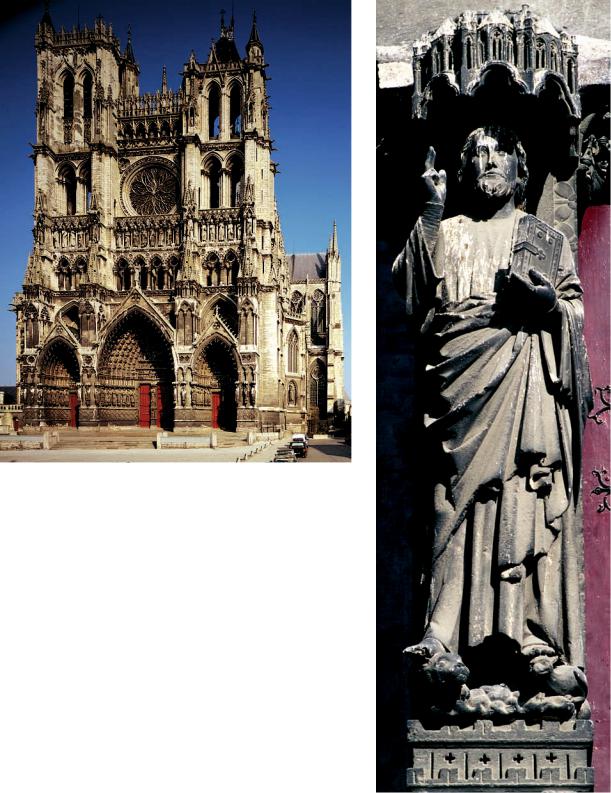
13-21 ROBERT DE LUZARCHES, THOMAS DE CORMONT, and RENAUD
DE CORMONT, west facade of Amiens Cathedral, Amiens, France, begun 1220.
The deep piercing of the Amiens facade left few surfaces for decoration, but sculptors covered the remaining ones with colonnettes, pinnacles, and rosettes that nearly dissolve the structure’s solid core.
Cathedral (FIG. 13-8) in the spacing of the funnel-like and gablecovered portals. But the Amiens builders punctured the upper parts of the facade to an even greater degree than did the Laon designer. The deep piercing of walls and towers at Amiens left few surfaces for decoration, but sculptors covered the ones that remained with a network of colonnettes, arches, pinnacles, rosettes, and other decorative stonework that visually screens and nearly dissolves the structure’s solid core. Sculpture also extends to the areas above the portals, especially the band of statues (the so-called kings’ gallery) running the full width of the facade directly below the rose window (with 15thcentury tracery). The uneven towers were later additions. The shorter one dates from the 14th century, the taller one from the 15th century.
BEAU DIEU The most prominent statue on the Amiens facade is the Beau Dieu (Beautiful God; FIG. 13-22) on the central doorway’s trumeau. The sculptor fully modeled Christ’s figure, enveloping his body with massive drapery folds cascading from his waist. The statue stands freely and is as independent of its architectural setting as any Gothic facade statue ever was. Nonetheless, the sculptor still placed an architectural canopy over Christ’s head. It is in the latest Gothic style, mimicking the east end of a 13th-century cathedral having a series of radiating chapels with elegant lancet windows. Above the canopy is the great central tympanum with the representation of Christ as Last Judge. The Beau Dieu, however, is a handsome, kindly
13-22 Christ (Beau Dieu), trumeau statue of central doorway, west facade,
Amiens Cathedral, Amiens, France, ca. 1220–1235.
The Beau Dieu is a kindly figure who blesses all who enter Amiens Cathedral. He tramples a lion and dragon symbolizing the evil
forces in the world. The Gothic Christ gives humankind hope in salvation.
figure who does not strike terror into sinners. Instead he blesses those who enter the church and tramples a lion and a dragon symbolizing the evil forces in the world. This image of Christ gives humankind hope in salvation. The Beau Dieu epitomizes the bearded, benevolent Gothic image of Christ that replaced the youthful Early Christian Christ (FIG. 8-8) and the stern Byzantine Pantokrator (FIGS. 9-1 and 9-25) as the preferred representation of the Savior in later European art. The figure’s quiet grace and grandeur also contrast sharply with the emotional intensity of the twisting Romanesque prophet (FIG. 12-11) carved in relief on the Moissac trumeau.
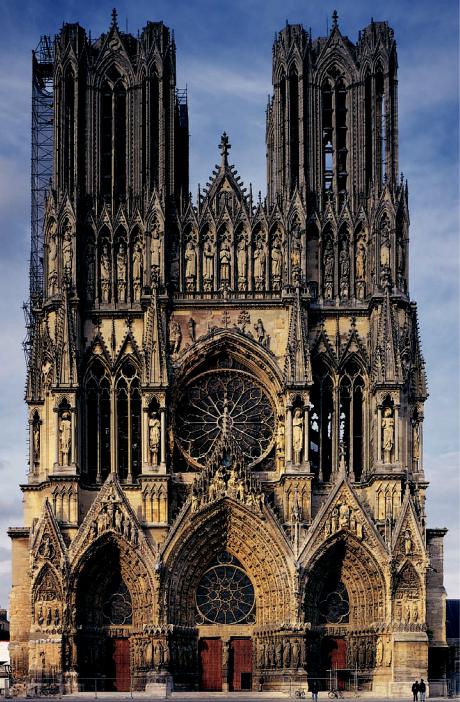
13-23 West facade of Reims Cathedral, Reims, France, ca. 1225–1290.
The facade of Reims Cathedral displays the High Gothic architect’s desire to reduce sheer mass and replace it with intricately framed voids. Stainedglass windows, not stone reliefs, fill the tympana.
REIMS CATHEDRAL Construction of Reims Cathedral (FIG. 13-23), where the coronations of the kings of France took place, began only a few years after work commenced at Amiens. The Reims builders carried the High Gothic style of the Amiens west facade still further, both architecturally and sculpturally. The two facades, although similar, display some significant differences. The kings’ gallery of statues at Reims is above the great rose window, and the figures stand in taller and more ornate frames. In fact, the designer “stretched” every detail of the facade. The openings in the towers and those to the left and right of the rose window are taller, narrower, and more intricately decorated, and they more closely resemble the elegant lancets of the clerestory within. A pointed arch also frames the rose window itself, and the pinnacles over the portals are taller and more elaborate than those at Amiens. Most striking, however, is the treatment of the tympana over the doorways, where stained-glass windows replaced the stone relief sculpture of earlier facades. The contrast with Romanesque heavy masonry construction (FIG. 12-30) is extreme. But no less noteworthy is the rapid transformation of the Gothic facade since the 12th-century designs of Saint-Denis and Chartres (FIG. 13-5) and even Laon (FIG. 13-8).
Reims Cathedral is also a prime example
of the High Gothic style in sculpture. The statues and reliefs of the west facade celebrate the Virgin Mary. Above the central gable, Mary is crowned as Queen of Heaven. On the trumeau, she appears in her role as the New Eve above reliefs depicting the Original Sin. The jamb statues relate episodes from the Infancy cycle (see “The Life of Jesus in Art,” Chapter 8, pages 216–217), including the Annunciation and Visitation (FIG. 13-24). All four illustrated statues appear to be completely detached from their architectural background. The sculptors shrank the supporting columns into insignificance so that they in no way restrict the free and easy movements of the fullbodied figures. These 13th-century statue-columns contrast strikingly with those of the Early Gothic Royal Portal (FIG. 13-7), where the background columns occupy a volume equal to that of the figures.
The Reims statues also vividly illustrate that the sculptural ornamentation of Gothic cathedrals took decades to complete and required many sculptors often working in diverse styles. Art historians
354 Chapter 13 G OT H I C E U RO P E
believe that three different sculptors carved the four statues in FIG. 13-24 at different times during the quarter century from 1230 to 1255. The Visitation group (FIG. 13-24, right) is the work of an artist who probably studied classical statuary. Reims was an ancient Roman city, and the heads of both Mary and Saint Elizabeth resemble Roman portraits. The Gothic statues are astonishing approximations of the classical naturalistic style and incorporate contrapposto postures that go far beyond the stance of the Chartres Saint Theodore (FIG. 13-18). The swaying of the hips is much more pronounced. The right legs bend, and the knees press through the rippling folds of the garments. The sculptor also set the figures’ arms in motion. Mary and Elizabeth turn their faces toward each other, and they converse through gestures. In the Reims Visitation group, the formerly isolated Gothic jamb statues became actors in a biblical narrative.
The Annunciation group (FIG. 13-24, left) also features statues liberated from their architectural setting, but they are products of
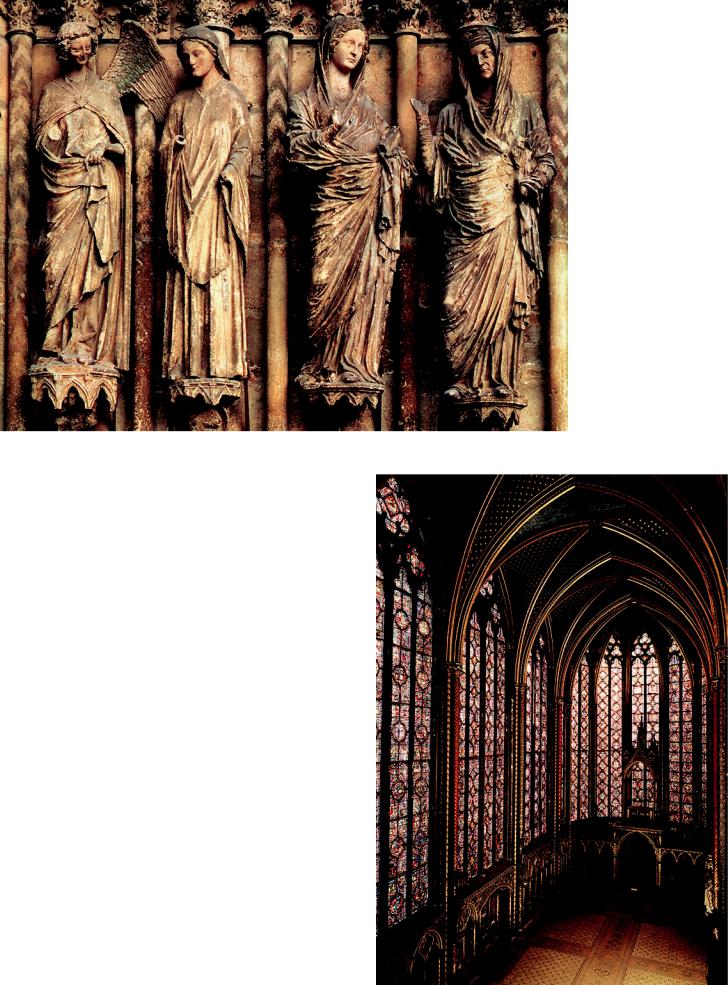
different workshops and one—the angel Gabriel—was first set in the left portal and then moved to its present location, which explains the stylistic dichotomy of the pair. Mary is a slender figure with severe drapery. The artist preferred broad expanses of fabric to the multiplicity of folds of the Visitation Mary. Gabriel, the latest of the four statues, has a much more elongated body and is far more animated. He exhibits the elegant style of the Parisian court at the middle of the 13th century. He pivots gracefully, almost as if dancing, and smiles broadly. Like a courtier, he exudes charm. Mary, in contrast, is serious and introspective and does not respond overtly to the news the angel has brought.
SAINTE-CHAPELLE, PARIS The stained-glass windows inserted into the portal tympana of Reims Cathedral exemplify the walldissolving High Gothic architectural style. The architect of SainteChapelle (FIG. 13-25) in Paris extended this style to an entire building. Louis IX built Sainte-Chapelle, joined to the royal palace, as a repository for the crown of thorns and other relics of Christ’s Passion he had purchased in 1239 from his cousin Baldwin II (r. 1228–1261), the last Latin emperor of Constantinople. The chapel is a masterpiece of the so-called Rayonnant (radiant) style of the High Gothic age, which dominated the second half of the century. It was the preferred style of the royal Parisian court of Saint Louis (see “Louis IX, the Saintly King,” page 360). Sainte-Chapelle’s architect carried the dissolution of walls and the reduction of the bulk of the supports to the point that some 6,450 square feet of stained glass make up more
13-25 Interior of the upper chapel (looking northeast), SainteChapelle, Paris, France, 1243–1248.
At Louis IX’s Sainte-Chapelle, the architect succeeded in dissolving the walls to such an extent that 6,450 square feet of stained glass account for more than three-quarters of the Rayonnant Gothic structure.
13-24 Annunciation and Visitation, jamb statues of central doorway, west facade, Reims Cathedral, Reims, France, ca. 1230–1255.
Different sculptors working in diverse styles carved the Reims jamb statues, but all detached their figures from the columns and set the bodies and arms in motion. The figures converse through gestures.
French Gothic |
355 |
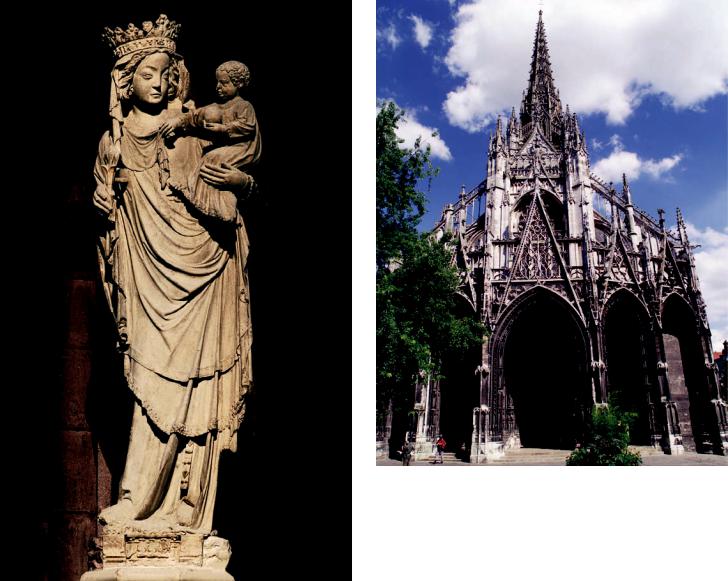
13-26 Virgin and Child (Virgin of Paris), Notre-Dame, Paris, France, early 14th century.
Late Gothic sculpture is elegant and mannered. Here, the solemnity of Early and High Gothic religious figures gave way to a tender and anecdotal portrayal of Mary and Jesus as royal mother and son.
than three-quarters of the structure. The supporting elements are hardly more than large mullions, or vertical stone bars. The emphasis is on the extreme slenderness of the architectural forms and on linearity in general. Although the chapel required restoration in the 19th century (after suffering damage during the French Revolution), it retains most of its original 13th-century stained glass. Sainte-Chapelle’s enormous windows filter the light and fill the interior with an unearthly rose-violet atmosphere. Approximately 49 feet high and 15 feet wide, they were the largest designed up to their time.
VIRGIN OF PARIS The “court style” of Sainte-Chapelle has its pictorial parallel in the mannered elegance of the roughly contemporaneous Gabriel of the Reims Annunciation group (FIG. 13-24, left), but the style long outlived Saint Louis and his royal artists and architects. The best example of the court style in Late Gothic sculpture is the early-14th-century statue nicknamed the Virgin of Paris (FIG. 13-26) because of its location in Paris at Notre-Dame. The sculptor portrayed Mary in an exaggerated S-curve posture typical of Late Gothic sculpture. She is a worldly queen, decked out in royal garments and wearing
356 Chapter 13 G OT H I C E U RO P E
13-27 West facade of Saint-Maclou, Rouen, France, ca. 1500–1514.
Saint-Maclou is the masterpiece of Late Gothic Flamboyant architecture. Its ornate tracery features curves and countercurves that form brittle decorative webs masking the building’s structure.
a heavy gem-encrusted crown. The Christ Child is equally richly attired and is very much the infant prince in the arms of his young mother. The tender, anecdotal characterization of mother and son represents a further humanization of the portrayal of religious figures in Gothic sculpture. Late Gothic statuary is very different in tone from the solemnity of most High Gothic figures, just as Late Classical Greek statues of the Olympian gods (compare FIG. 13-26 with FIG. 5-63) differ from High Classical depictions.
SAINT-MACLOU, ROUEN Late French Gothic architecture also represents a departure from the norms of High Gothic. The change from Rayonnant architecture to the so-called Flamboyant style (named for the flamelike appearance of its pointed bar tracery) occurred in the 14th century. The style reached its florid maturity nearly a century later in Normandy in the church of Saint-Maclou (FIG. 13-27) in Rouen, its capital. The church is tiny (only about 75 feet high and 180 feet long) compared with the cathedrals of the High Gothic age. Its facade breaks sharply from the High Gothic style (FIGS. 13-21 and 13-23) of the 13th century. The five portals (two of them false doors) bend outward in an arc. Ornate gables crown the doorways, pierced through and filled with wiry, “flickering” Flamboyant tracery made up of curves and countercurves that form brittle decorative webs and mask the building’s structure. The transparency of the pinnacles over the doorways permits visitors to see the central rose window and the flying buttresses, even though they are set well back from the facade. The overlapping of all features, pierced as they are, confuses the structural lines and produces
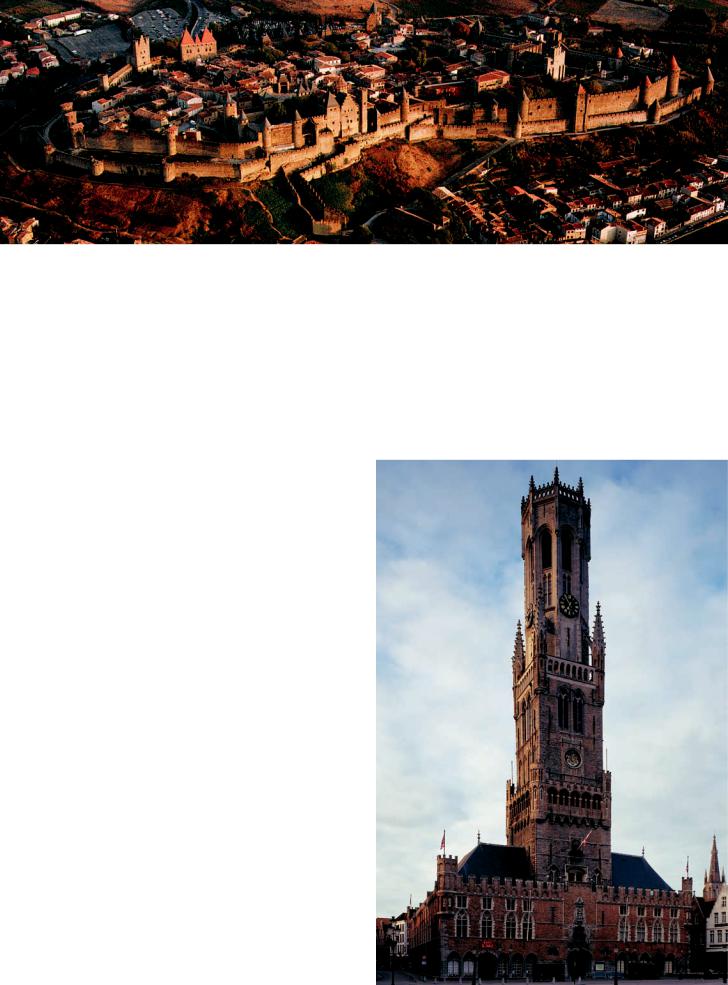
13-28 Aerial view of the fortified town of Carcassonne, France. Bastions and towers, 12th–13th centuries, restored by EUGÈNE VIOLLET-LE-DUC in the 19th century.
Carcassonne provides a rare glimpse of what was once a familiar sight in Gothic France: a tight complex of castle, cathedral, and town with a crenellated and towered wall circuit for defense.
a bewildering complexity of views that is the hallmark of the Flamboyant style.
CARCASSONNE The Gothic period has been called “the age of great cathedrals,” but people, of course, also needed and architects also built secular structures such as town halls, palaces, and private residences. In an age of frequent warfare, the feudal barons often constructed fortified castles in places enemies could not easily reach. Sometimes thick defensive wall circuits, or ramparts, enclosed entire towns. In time, however, purely defensive wars became obsolete due to the invention of artillery and improvements in siege craft. The fortress era gradually passed, and throughout Europe once-mighty ramparts fell into ruin.
One of the most famous Gothic fortified towns is Carcassonne (FIG. 13-28) in Languedoc in southern France. It was the regional center of resistance to the northern forces of royal France. Built on a hill bounded by the Aude River, Carcassonne had been fortified since Roman times. It had Visigothic walls dating from the 6th century, but in the 12th century masons reinforced them. Battlements (low parapets) with crenellations (composed of alternating solid merlons and open crenels) protected guards patrolling the stone ring surrounding the town. Carcassonne might be forced to surrender but could not easily be taken by storm. Within the town’s double walls was a fortified castle (FIG. 13-28, left) with a massive attached keep, a secure tower that could serve as a place of last refuge. Balancing that center of secular power was the bishop’s seat, the Cathedral of Saint-Nazaire (FIG. 13-28, right). The small church, built between 1269 and 1329, may have been the work of an architect brought in from northern France. In any case, Saint-Nazaire’s builders were certainly familiar with the latest developments in architecture in the Île-de-France. Today, Carcassonne—as restored in the 19th century by EUGÈNE VIOLLET-LE-DUC (1814–1879)—provides a rare glimpse of what was once a familiar sight in Gothic France: a tightly contained complex of castle, cathedral, and town within towered walls.
13-29 Hall of the cloth guild, Bruges, Belgium, begun 1230.
The Bruges cloth guild’s meeting hall is an early example of a new type of secular architecture in the late Middle Ages. Its lofty tower competed for attention with the towers of the city’s cathedral.
GUILD HALL, BRUGES One of the many signs of the growing secularization of urban life in the late Middle Ages was the erection of monumental meeting halls and warehouses for the increasing number of craft guilds being formed throughout Europe. An early example is the imposing market and guild hall (FIG. 13-29) of the
French Gothic |
357 |
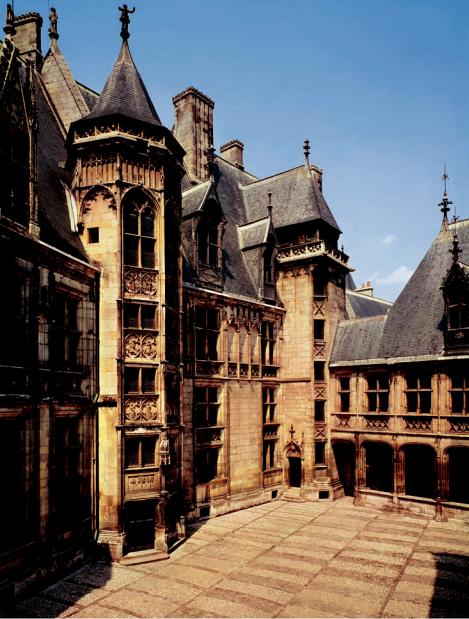
13-30 House of Jacques Coeur, Bourges,
France, 1443–1451.
The house of the immensely wealthy Bourges financier Jacques Coeur is both a splendid example of Late Gothic architecture with elaborate tracery and a symbol of the period’s new secular spirit.
clothmakers of Bruges, begun in 1230. Situated in the city’s major square, it testifies to the important role of artisans and merchants in Gothic Europe. The design combines features of military (the corner “watchtowers” with their crenellations) and church (lancet windows with crowning oculi) architecture. The uppermost, octagonal portion of the tower with its flying buttresses and pinnacles dates to the 15th century, but even the origi-
nal two-story tower is taller than the rest of the hall. Lofty towers were a common feature of late medieval guild and town halls, designed to compete for attention and prestige with the towers of city cathedrals.
HOUSE OF JACQUES COEUR The fortunes of the new class of wealthy merchants who rose to prominence throughout Europe in the late Middle Ages may not have equaled those of the hereditary royalty, but their power and influence were still enormous. The career of the French financier Jacques Coeur (1395–1456) illustrates how enterprising private citizens could win—and quickly lose— wealth and power. Coeur had banking houses in every city of France and many cities abroad. He employed more than 300 agents and competed with the great trading republics of Italy. His merchant ships filled the Mediterranean, and with the papacy’s permission, he imported spices and textiles from the Muslim Near East. He was the treasurer of King Charles VII (r. 1422–1461) of France and a friend of Pope Nicholas V (r. 1447–1455). In 1451, however, his enemies framed him on an absurd charge of having poisoned Agnes Sorel, the king’s mistress. The judges who sentenced Coeur to prison and confiscated his vast wealth and property were among those who
358 Chapter 13 G OT H I C E U RO P E
owed him money. Coeur escaped in 1454 and made his way to Rome, where the pope warmly received him. He died of fever while leading a fleet of papal war galleys in the eastern Mediterranean.
Jacques Coeur’s great town house still stands in his native city of Bourges. Built between 1443 and 1451 (with special permission to encroach upon the town ramparts), it is the best-preserved example of Late Gothic domestic architecture. The house’s plan is irregular, with the units arranged around an open courtyard (FIG. 13-30). The service areas (maintenance shops, storage rooms, servants’ quarters, and baths—a rare luxury in Gothic Europe) occupy the ground level. The upper stories house the great hall and auxiliary rooms used for offices and family living rooms. Over the main entrance is a private chapel. One of the towers served as a treasury. The exterior and interior facades have very steep pyramidal roofs of different heights. The decorative details include Flamboyant tracery and large pointed-arch stained-glass windows. An elegant canopied niche facing the street once housed a royal equestrian statue. A comparable statue of Coeur on horseback dominated the facade opening onto the interior courtyard. Jacques Coeur’s house is both a splendid example of Late Gothic architecture and a monumental symbol of the period’s new secular spirit.
